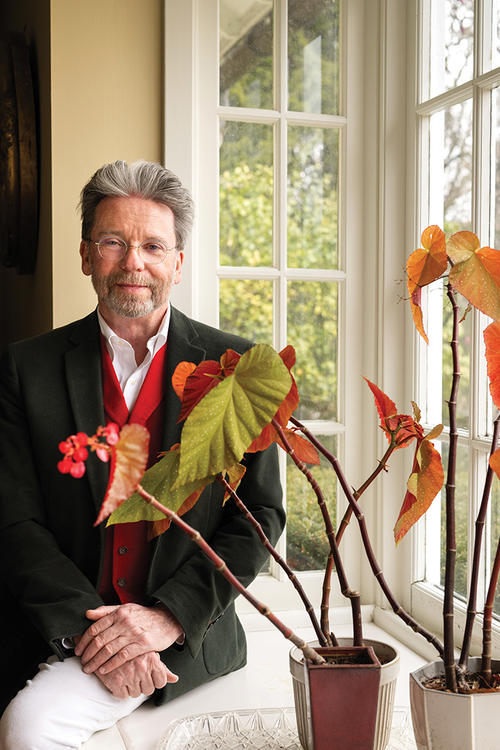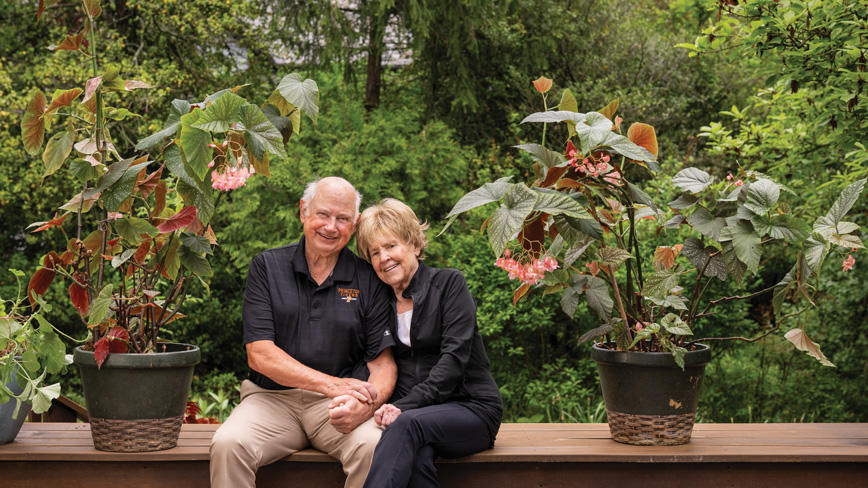
Einstein’s Begonia
The famed physicist’s legacy quietly lives on with cuttings from his flowering plant shared in Princeton and worldwide
For the last two decades of his life, Albert Einstein lived in a white roadside colonial at 112 Mercer St. Often, he would make the mile walk to his workplace, the Institute for Advanced Study. He was arguably the most famous person in Princeton, and indisputably the most recognizable one, a small man with an untamed thatch of white hair who eschewed wearing socks and often seemed lost in thought to passersby.
More than 100 years after he won the Nobel Prize in physics and 70 years after his death in Princeton Hospital, the name Albert Einstein remains synonymous with brilliance. His theories of relativity — special and general — revolutionized the way scientists understood time, space, and gravity, reframing the prevailing constructs of light and matter.
“Einstein remains the last, and perhaps only, physicist ever to become a household name,” James Overduin, a theoretical physicist at Towson University in Maryland, once said.
Few people can appreciate Einstein’s cosmos-changing genius more than A.J. Stewart Smith *66, a renowned physicist in his own right who came to Princeton in 1961, enrolling in graduate school six years after Einstein’s death. Born in Victoria, British Columbia, Smith was a decorated student at the University of British Columbia as well as a standout athlete in lacrosse and rugby. He went on to earn his doctorate and joined the faculty after receiving offers from both Princeton and M.I.T.
“If it was good enough for Einstein, I figured it must be OK,” Smith says.
Smith, whom most everyone around campus knows as Stew, went on to an illustrious half-century career spanning from 1968 until his retirement at the age of 80 in 2018. Apart from being a physics professor, Smith served as department chair, conducted research in his specialty — particle physics — at top laboratories around the country, and ultimately became Princeton’s first dean of research, serving from 2006 to ’13. These days, Stew Smith has an entirely different calling. An accomplished gardener, he is the unofficial caretaker, and most prolific propagator, of Albert Einstein’s most improbable, and overlooked, legacy: Einstein’s begonia.
A variety commonly known as an angel wing, Einstein’s begonia is the hybrid progeny of a Californian named Eva Kenworthy Gray, an amateur breeder who, nearly 100 years ago, crossed a Brazilian begonia (Begonia aconitifolia) with a Swiss plant (B. coccinea Lucerna). Her creation was christened an angel wing because that’s what its leaves resembled. It is characterized by thick stems and vibrant colors, easily identifiable by the wing-like leaves that often are speckled, polka-dotted, or cloaked in metallic silver. A descendant of Gray’s creation somehow found its way to Einstein’s yard on Mercer Street. It has quietly gained an almost cult-like standing among Princeton’s gardening set, not merely as a plant but as a conversation piece in dirt — leafy, living proof that you are part of a begonia brotherhood (and sisterhood). Through the horticultural wonder of cuttings (put a stem in water and wait for fresh roots to grow), it has traveled to gardens or windowsills all over the country, as well as to Canada, Germany, and Norway, and to many more spots right in the neighborhood, such as the one in the Nassau Street office of Ruthie Boyce, program coordinator for community college engagement at Princeton’s McGraw Center for Teaching and Learning.
“It’s cuttings and cuttings and cuttings, and it just goes on,” Boyce says.
It is even the subject of a musical (www. einsteinsbegonia-musical.com), created and composed by Rebecca Pronsky, a Brooklyn-based songwriter. The idea took root one day when Pronsky was walking in the garden of her father’s cousin in Cranford, New Jersey.
“Here’s Einstein’s begonia,” the cousin said.
“What’s Einstein’s begonia?” Pronsky asked. Soon she was as captivated as everyone else. Pronsky had just lost her father, and it occurred to her that the begonia had lost its father (Einstein), too. She started writing songs from the perspective of the begonia, describing the production as both funny and dark. “The whole show is recovering from loss, finding your family, and the journey to heal,” Pronsky says. It’s still in development, but her dream is to debut it on the Princeton campus.
Nobody has done more to spread the story of Einstein’s begonia than Norma Smith, Stew’s wife of 59 years. Stew has almost certainly propagated more cuttings of Einstein’s begonia than anyone on earth, and Norma, an outgoing, community-minded person, is equally prolific in sharing them with friends at the senior center, neighbors, visitors, anyone who asks.
After a writer for PAW visited the Smiths this spring, Norma insisted on sending him home with a cutting.
“She’s the Johnny Appleseed of Einstein’s begonia,” Stew says. He smiles and looks at Norma, who is sitting in a chair alongside — you guessed it — an offspring of Einstein’s begonia. It is almost 4 feet high. She has had it for 25 years.
“People love to have them,” she says.
Before he died, Einstein gave his begonia to Helen Dukas, his longtime personal secretary who lived in Einstein’s Mercer Street home. She thought it would be nice to offer cuttings to Princeton University physicists, many of whose careers were deeply impacted by Einstein.
Among the first to receive a cutting was Sam Bard Treiman, a World War II veteran and an acclaimed particle physicist who arrived in Princeton in 1952 and ultimately became the Higgins Professor of Physics Emeritus. Treiman and his wife, Joan, in turn gave a cutting to David Wilkinson, Princeton’s Cyrus Fogg Brackett Professor of Physics Emeritus and a scholar who was instrumental in the development in the 1960s of the Big Bang theory of the universe. Wilkinson’s wife, Eunice, was completely enamored of the plant and shared it with Norma Smith. Stew Smith never met Einstein, but knew exactly how to care for his begonias, which he has made a fixture in his verdant backyard. Every October, Stew and Norma Smith began to offer the begonias in their garden to anyone who would like to pot them and bring them inside for the winter.
Johanna Fantova, a close companion of Einstein in his final years, was also a circulator of Princeton’s most prized plant. Twenty-two years younger than Einstein, she was widely known around town as his last girlfriend. Einstein loved to sail, and Fantova would often join him on Lake Carnegie. They went to concerts together and Fantova even took on the daunting task of cutting Einstein’s famously unruly hair.
A former curator of maps at Firestone Library, Fantova kept a diary detailing many of their outings and the events of his final years, and before she died in 1981, she gave the original begonia from Einstein’s house (it isn’t clear if there was more than one) to her niece, Miranda Short.
Short, who still lives in Princeton, passed on a cutting to her friend Mimi Omiecinski, the founder of Princeton Tour Company and a woman who celebrates Pi Day every March 14, in part because 3.14 is the numerical equivalent of pi, but also because it was Einstein’s birthday. Events include a Pi-rade, a pie-judging contest, a Pi Day Einstein Pub Crawl, and an Einstein Look-Alike competition. Stops at 112 Mercer and a discussion of Einstein’s begonia are part of the company’s walking tours, which highlight Princeton’s history and its most notable residents.
“Princeton is honored to host the world to celebrate our most beloved Princeton genius,” Omiecinski writes on her website.

Living in a gardenless apartment, Omicienski offered her cutting to James Steward, a good friend and avid gardener who is the director of the Princeton University Art Museum. That was eight years ago. Steward now has three of the plants in a bay window of his home, and though he wonders sometimes if his plants are actual descendants of Einstein’s — “I don’t think there’s DNA testing for begonias,” he says — he is deeply grateful to Omiecinski for thinking of him.
“Honestly, I’m really a perennial gardener,” Steward says. “I love plants that go into the ground over winter and then by some miracle come back to us in the spring. My affection for these begonias is entirely their oral history, the sense that they connect us to lives lived and lost, in this case one of the great minds of the 20th century. I feel the responsibility of keeping them alive and healthy, like I’m the keeper of the flame. These plants give me hope that life goes on seemingly against the odds.”
The idea that people would get so attached to a garden-variety plant has everything to do with Einstein the man and how he lived his life. He was, by almost all accounts, a wry, witty fellow who was an inveterate nonconformist and fascinated by children. “Play is the highest form of research,” he once said. He was that rare genius with an endearing, everyman appeal. He not only didn’t court fame; he would’ve preferred to have no part of it.
“In the past it never occurred to me that every casual remark of mine would be snatched up and recorded,” he told one biographer. “Otherwise, I would have crept further into my shell.”
Einstein also was a deeply committed humanitarian — a quality that his towering scientific achievements make easy to overlook.
Growing up in Germany, he had a commitment to peace and justice that endured for his entire life. He was a fierce opponent of German militarism and ubernationalism in the years leading up to World War I, and during the years of the Weimar Republic (1918-33) he was not just a vocal pacifist but among the leading edge of thinkers who foresaw the profound perils that Hitler embodied.
He was an ardent supporter of a Jewish homeland in the Middle East, but believed that cooperation between Jews and Arabs needed to undergird it. In 1946, on one of the rare occasions he agreed to give a commencement address, he told the graduates of Lincoln University, a historically Black college in Pennsylvania, that there were many things he admired about American society. Then he added, “There is, however, a somber point in the social outlook of Americans. Their sense of equality and human dignity is mainly limited to men of white skins.”
Omiecinski believes the popularity of Einstein’s begonia is no homegrown accident.
“When you have a living thing that connects back to such an incredible human soul, it means something,” she says. “It’s touching. It makes us all better.”
Stew and Norma Smith are standing in the kitchen of their nearly 100-year-old home on a warm spring day, gazing over a backyard that could be out of a landscaping magazine. It has been a work in progress from the day they moved in 47 years ago.
It features a sod-farm-quality lawn and a large tulip magnolia tree that is framed by forsythia and an assortment of daffodils, tulips, aconite, japonica, and mahonia (Oregon grapes), plantings designed to keep something in bloom all summer. In May, phlox takes the lead, followed by cleomes and crepe myrtles, and then there is maybe the world’s largest collection of Einstein’s begonia, in all their angel-wing glory, flourishing in the shade beneath the magnolia tree.
Scarcely a half mile from 112 Mercer St., Stew and Norma Smith love to sit on their deck on summer evenings, taking it all in, careful custodians of Albert Einstein’s most overlooked legacy.
Wayne Coffey is a freelance journalist and the author of more than 30 books. He lives in Sleepy Hollow, New York.







8 Responses
Harry Dreier
2 Months AgoSeeking a Cutting of Einstein’s Begonia
This is a great article. Thank you. I am hoping it might be possible to obtain a cutting from Einstein’s begonia. Let me briefly explain why.
My mother and her siblings grew up in Princeton. My grandfather, Isadore Braveman, had a jewelry shop in town and was a founding member of The Jewish Center. I suspect because of they were both ardent Zionists, Dr. Einstein and my grandfather became friends. According to a book about Dr. Einstein, his watch was kept running by a “Jewish jeweler”; that was my grandfather. (He also repaired the wood clock in the old Nassau Inn.) Einstein actually wrote a letter of recommendation for my uncle to get into medical school. My mother used to tell us stories of visiting his home and us sitting on his lap. I only wish I had a photo.
Anyway, hopefully you can understand why I have an affinity for Dr. Einstein. It certainly isn’t physics, which I am nowhere near smart enough to understand. And hopefully you can understand as well why having a piece of that plant would be quite significant to me.
If it would be possible for me to get in touch with someone who has a plant originating from Einstein’s Begonia and might be willing to share a cutting with me, I would greatly appreciate it (contact harry.dreier@gmail.com).
Also, I saw the mention of the musical “Einstein’s Begonia” in the comments and would love to see the show. Are there any plans for future performances?
Michael Fisher
5 Months AgoBeyond the Princeton Bubble
Not an alum, but Princeton was my second choice — :=) — to Emory University.
Living now in the Smokey Mountains where a cutting was gifted to me by two North Carolina college professors. They did that not knowing what an Einstein fan I have long been. Retired lawyer who likes physics? It happens.
I have several plants grown from their small cutting, but the original and largest sits near a painting of the great man by Georgia artist Steve Penley.
Kyla Terhune ’96
5 Months AgoA Thriving, Growing Legacy
Thank you for this article. My husband and I are Class of ’96. When we were at our 20th reunion, we visited Marue Walizer, former director of the Teacher Prep program and a dear friend and mentor. She had an Einstein begonia and a cutting was on the windowsill, which she offered to me. Even more so than the novelty of it being from Einstein, the deep meaning was that it was from her, one of my educators. She was able to name the women it came from, back to Helen Dukas. It was four removed from Einstein. We drove the cutting back to Nashville, in 100+ degree weather, where I was at the time a program director for the surgery residency. It thrived. I have the original which I have potted and repotted every year and have another 20 plants probably within our home, various shapes and sizes. I began to give it to our chief residents on graduation. Fast forward to today. Here in Nashville, the Einstein begonia thrives. I’ve given away over 300 cuttings — to students, residents, program directors, colleagues, hospital staff who love and appreciate plants, relatives, to friends who have traveled on beyond Nashville. I encourage others to keep track of whom they give it to and to know why. Probably the most meaningful was when I gave a cutting to one of my own mentors, a senior surgeon. Years later, when he passed away, I was at visitation in his son’s home, and there was an Einstein begonia, thriving. This is truly a wonderful legacy that reminds us of the permanence of so much beyond us. At least weekly, a former colleague, mentee, student, resident, friend, sends a photo of their cutting to remind me that it is thriving, as hopefully they are too. Thank you.
Marc Lange ’85
6 Months AgoMisplay in a Quote Attributed to Einstein
Evidently, the only things that propagate faster than Einstein’s begonia are light and misattributions of quotations to Einstein. According to “Einstein's Begonia” (June issue), Einstein once said, “Play is the highest form of research.” But The Ultimate Quotable Einstein (Princeton University Press, 2011, p. 482) classifies this remark with many others under the heading “Probably Not By Einstein.” Einstein might have agreed with what Yogi Berra supposedly said: “I really didn’t say everything I said.”
Rob Slocum ’71
3 Months AgoTeaching Relativity (and Baseball)
The letter about Einstein, Yogi Berra, and misquotation brings to mind another story, and another MLB catcher: Princeton’s own Moe Berg 1923.
In Berg’s recollection of a meeting with Einstein, which appears in Nicholas Dawidoff’s The Catcher Was a Spy, Einstein told him, “Mr. Berg, you teach me baseball and I will teach you the theory of relativity,” and then, after a pause, decided, “No, we must not. You will learn relativity faster than I will learn baseball.”
Nadia Zakamska *05
6 Months AgoMore Begonia Connections in Physics Community
Thank you so much for this wonderful and interesting piece. I am one of the owners of Einstein’s begonia, which I got from Scott Tremaine (formerly the chair of Princeton astrophysics), who in turn got it from Lyman Page (formerly the chair of Princeton physics), and although I don’t know the exact steps that lead from Professor Page to Einstein, I trust that from this point the provenance of the plant does not need to be proved any further. The reason I am writing is that James Overduin, mentioned in the beginning of the article with a quote unrelated to begonia, is actually an owner of Einstein begonia, which he got from me! I thought the readers might be amused to know about even more begonia connections than those covered in the article.
Ken McCarthy ’81
6 Months AgoAnother Legacy of Einstein
Einstein left another little-known legacy from his Princeton days. It’s a letter he cosigned with Hannah Arendt and was published in The New York Times on Dec. 4, 1948.
This excerpt is made up of exact quotes from the letter: “Several Americans of national repute have lent their names to welcome his [Menachem Begin’s] visit. … A shocking example [of Begin’s party] was their behavior in the Arab village of Deir Yassin. … [T]errorist bands attacked this peaceful … [and] killed most of its inhabitants. … Most of the Jewish community was horrified at the deed … . But the terrorists, far from being ashamed of their act, … invited foreign correspondents present in the country to view the heaped corpses and the general havoc … . [His party has] preached an admixture of ultranationalism, religious mysticism, and racial superiority.”
As the much-censored Jewish-American investigative journalist George Seldes like to say: “Even the Gods can’t change history.” The Princeton community’s silence and tolerance of, in my view, the very public genocide taking place in Gaza now will leave a stain on the University’s reputation that not even 1,000 years will be able to wash away.
Rebecca Pronsky
6 Months AgoEinstein’s Begonia Musical in Concert
Hello! I’m one of the writers of the musical “Einstein's Begonia” and am quoted in the article. I wanted to let folks know that we will be doing a free concert performance of the show at the Princeton Public Library on Sunday, Sept. 7 at 3 p.m. We are proud to be part of the begonia’s legacy and look forward to presenting songs from the show in Princeton soon. More info is at einsteinsbegoniamusical.com.